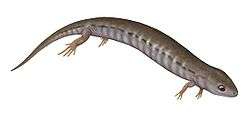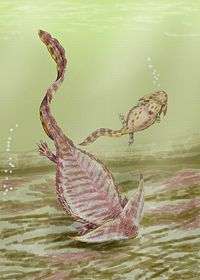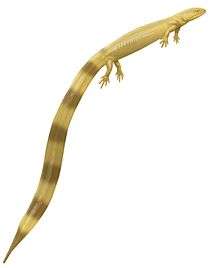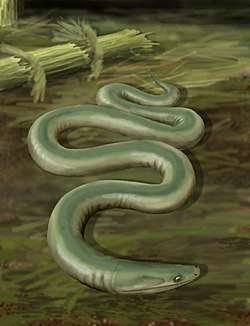Llistrofus
Llistrofus is an extinct genus of early Permian microsaur within the family Hapsidopareiidae that is known from Oklahoma.
| Llistrofus | |
|---|---|
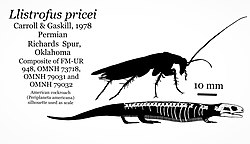 | |
| Skeletal diagram of Llistrofus pricei, with an American cockroach used as scale | |
| Scientific classification | |
| Kingdom: | |
| Phylum: | |
| Class: | |
| Subclass: | |
| Order: | |
| Suborder: | |
| Family: | |
| Genus: | Llistrofus Carroll & Gaskill, 1978 |
| Type species | |
| Llistrofus pricei Carroll & Gaskill, 1978 | |
Discovery
Llistrofus was described by Canadian paleontologists Robert Carroll and Pamela Gaskill in 1978.[1] The genus name is an anagram of Fort Sill, the historic name of the Richards Spur locality from which material of Llistrofus was collected. The species name, L. pricei, is given for the Brazilian paleontologist Llewellyn Price. The holotype of this taxon is currently reposited at the Field Museum of Natural History. The skull of the holotype was reappraised by Bolt & Rieppel in 2009.[2] New material from Richards Spur was described by Gee et al. (2019).[3]
Description
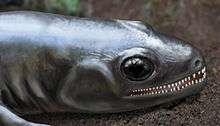
Llistrofus is readily identified by the presence of a large temporal emargination, a feature shared with Hapsidopareion lepton that unites the Hapsidopareiidae. Carroll & Gaskill (1978) differentiated Llistrofus from Hapsidopareion by four features: (1) postorbital contacting the tabular; (2) postparietal contacting the squamosal; (3) frontals entering the orbit; and (4) presence of a quadratojugal.[1] Bolt & Rieppel (2009) revised the diagnosis following additional preparation of the holotype's skull and list three features (only one of which is shared with the previous work): (1) skull length approximately twice that of Hapsidopareion; (2) frontals entering the orbit; and (3) cultriform process of the parasphenoid offset from the basal plate by a narrow base.[2] Gee et al. (2019) further revised the diagnosis based on additional material from Richards Spur and listed 11 features: (1) frontals entering the orbit; (2) prefrontal entering the naris; (3) premaxilla contributing to ventral narial margin; (4) postfrontal excluded from the temporal emargination; (5) postorbital contacting the tabular; (6) denticles on the vomer; (7) teeth on the palatine smaller than the marginal teeth; (8) absence of a pterygoid-premaxilla contact; (9) a splenial that contributes to the symphysis; (10) presence of a Meckelian foramen; and (11) presence of a retroarticular process.[1]
Classification
Llistrofus is recovered as the sister taxon to Hapsidopareion in phylogenetic analyses, producing the Hapsidopareiidae.[3]
References
- Carroll, Robert L.; Gaskill, Pamela (1978). The order Microsauria. Philadelphia: American Philosophical Society. ISBN 0871691264. OCLC 4314948.
- Bolt, John R.; Rieppel, Olivier (2009). "The holotype skull of Llistrofus pricei Carroll and Gaskill, 1978 (Microsauria: Hapsidopareiontidae)". Journal of Paleontology. 83 (3): 471–483. doi:10.1666/08-076.1. ISSN 0022-3360.
- Gee, Bryan M.; Bevitt, Joseph J.; Garbe, Ulf; Reisz, Robert R. (2019-01-25). "New material of the 'microsaur' Llistrofus from the cave deposits of Richards Spur, Oklahoma and the paleoecology of the Hapsidopareiidae". PeerJ. 7: e6327. doi:10.7717/peerj.6327. ISSN 2167-8359. PMC 6348957. PMID 30701139.
See also
- Prehistoric amphibian
- List of prehistoric amphibians
